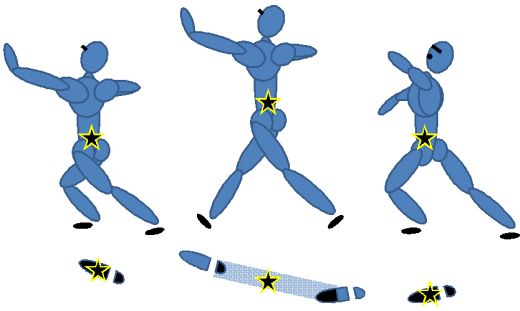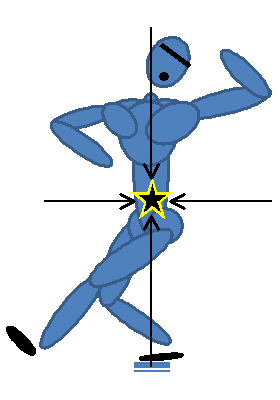1
Physics in Ballroom Dancing: Balance and Stability.
Text: Kerstin Lange Photography and Diagrams: Helmut Römhild
To dance means to move.
But it is also true that dancing is about how to stand correctly:
balance and stability are extremely important for a dancer.
To understand what happens in the state of balance and what stability means it
helps to keep in mind that dancing takes place on the surface of planet Earth.
Here forces act on the dancer’s body in a characteristical way.
Gravity pulls the body to the floor, the floor counters with a ‘push’, providing support and friction.
Muscles move the dancer’s body working against gravity and support while other forces outside the body
(e.g. the partner) add to the sum of forces and counterforces, of pushes and pulls in and from various directions.
In physics the forces simultaneously acting and counteracting upon a body are added
resulting in a net (or remaining) force.
If the result is zero nothing happens to the body.
If it is not zero the body is moved in the direction of the remaining force.
In physics a body can be represented by one point: the center of gravity.
Bodies are complex: they have various shapes and they can change their shapes.
In physics the body can be represented by one point:
the center of gravity.
Here the effect of gravity and other forces
is the same as on all the different parts of the body.
Put a long ruler across your index finger.
When it is in balance the center of gravity is where it rests on your finger.
Based on experiences like this the normal understanding is
that the center of gravity has something to do with the ‘middle’ of objects.
In fact it can also lie outside objects depending on the shape!
The implication is: If a body changes its shape the center of gravity moves.
It can move from the center of the body to the skin, from the belly to the chest,
further and further, until it is outside the body.
Physics in Dancesport.
The biomechanics of Ballroom Dancing combines the physical and anatomical dimensions of movement and rest.
In the articles ‘Physics in Ballroom Dancing’ you find considerations about the physical framework inside which dancesports happens.
The physical basics discussed in this article are taken from the following publications:
Prof. Dr. George D. Gollin, The Physics of Dance, University of Illinois, 2001.
Prof. Dr. Kenneth Laws, Physics and the Art of Dance, Oxford University Press, 2002.
Balance: a vertical achievement.
The floor provides support.
In physical terms it provides a counterforce to gravity pulling the body downwards:
Support means a force of equal strength pushing upwards.
The net sum of gravity pulling downwards and the floor pushing upwards is zero.
Also other forces acting upon the body are either non-existent or their sum is zero.
The fundament: area of support.

The illustration above shows examples of areas of support in relation to the center of gravity situated above them.
The size of the area of support can change dramatically.
It depends on whether the dancer stands on both feet or on one, with feet close together or apart,
on balls or heels.
In reality there is no need to exactly align the center of gravity and the area of support vertically.
It is sufficient to keep the center of gravity inside the area of support.
But as soon as the area of support becomes very small an exactly vertical alignment is necessary.
Balance maintained: stability.
The center of gravity shifts when the body changes shape.
This happens frequently during movement or while starting or stopping movement.
The ability to stay balanced while moving is essential.
Stability during movement means to keep the center of gravity inside an area of support which
permanently changes size and position.
Here the dancer can maintain balance by expanding the area of support.
Expanding the area of support.

When moving, the dancer has to transport the center of gravity from point A to point B.
This is usually done by stepping forward: from a one-foot support to the next one-foot support.
If between start and finish both feet have ground contact the area of support is significantly enlarged
giving the dancer’s body has a better stability:
now that the transportation of the center of gravity can be done across a larger area of support
it is easier to keep the center gravity inside its boundaries.
Of course it is still quite narrow between the left-right boundaries so alignment is still necessary.
![]()
©: Ballroom Website, 2010
Aktualisiert: 05.04.2010


